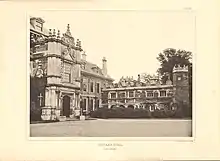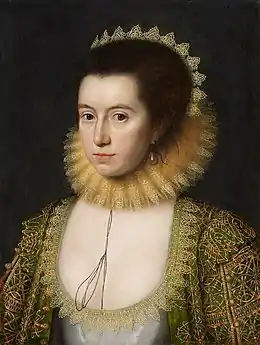Thomas Griffin (died 1615)
Thomas Griffin (1580-1615) was an English landowner and hosted the royal family at Dingley.

Thomas Griffin was the eldest son of Sir Thomas Griffin of Dingley, Braybrooke, and Gumley Ewing and Lucy Conyers (d. 1620), a daughter of Richard Conyers of Wakerley.[1][2] A miniature portrait of Thomas Griffin by Nicholas Hilliard has the inscription "Anno Domini 1599, Aetatis Suae 20', he was born early in 1580.[3][4]
Anne of Denmark, Princess Elizabeth, and Prince Henry at Dingley

In 1603 Queen Elizabeth died. James VI of Scotland became king, an event known as the Union of the Crowns. His wife, Anne of Denmark came to England in June 1603, and noblewomen and gentry travelled to meet her, perhaps in hope of gaining favour or employment in the royal household. One of the places where Anne of Denmark stayed and received guests was Griffin's house at Dingley Hall in Northamptonshire.[5] Dingley Hall had been rebuilt in the 1550s by Edward Griffin and his second wife Anne Smith, daughter of John Smith, baron of the Exchequer, and the porch is carved with the date 1558 and their initials, and other inscriptions.[6][7]
Lady Anne Clifford came to see the new queen and Prince Henry at Dingley, and wrote about her journey from London. She rode to Tittenhanger Park, and met her mother, the Countess of Cumberland, and the next day rode to Wrest Park which was deserted and locked up. After a night at Rockingham Castle they went to Lady Nedham's house at Litchborough, and then perhaps at Wymondley Priory met Lucy Russell, Countess of Bedford, who had attended Anne of Denmark from Edinburgh. They went together to Dingley.[8][9]
At Dingley on 24 June, she and her party were presented to the queen who greeted them with a kiss. Three favourites of Sir Robert Cecil were there, the Lady Suffolk, the young Lady Derby, and Lady Walsingham.[10] Princess Elizabeth went to Coombe Abbey near Coventry. After a night at Dingley, Anne Clifford travelled a day south with the queen's party towards Althorp, then she and her mother and her cousin Anne Vavasour rode to Coventry to see Princess Elizabeth.[11]
Later life
He died in 1615, and his estates passed to his younger brother, Sir Edward Griffin.[12]
His wife, Lady Griffin, attended the funeral of Anne of Denmark in 1619 as a lady of the Privy Chamber.[13]
Marriages
Thomas Griffin married Catherine Monson, daughter of Sir John Monson of Carlton. He married secondly,[14] Elizabeth Touchet (d. 1662), a daughter of George Touchet, Lord Audley, (she was the widow of Sir John Stawell or Stowell of Cothelstone, and mother of John Stawell), but had no male heir.[15][16]
Lucy Griffin, the daughter of Thomas Griffin and Elizabeth Touchet, married Sir Richard Wiseman of Torrell's Hall, Willingale, Essex.[17]
References
- John Nichols, History and antiquities of the county of Leicester, 2: 2 (London, 1798 repr. 1971), p. 592.
- Joseph Jackson Howard, 'Parish Registers of Wakerley', Miscellanea genealogica et heraldica, new series, vol. 1 (London, 1874) p. 416, they married at Wakerley in 1569.
- Archaeological Journal, 17 (London, 1860), p. 278, miniatures at Audley End.
- William Paily Baildon, Braybrooke: its castle, manor and lords, pp. 76, 78-9 plate.
- John Nichols, Progresses of James the First, vol. 1 (London, 1828), pp. 172-3.
- John Alfred Gotch & Charles Latham, Architecture of the Renaissance in England, vol. 1 (London, 1894), p. 42 and plates.
- Walter C. Metcalfe, Visitation of Northamptonshire (London, 1887), p. 24.
- John Nichols, Progresses of James the First, vol. 1 (London, 1828), p. 174.
- Jessica L. Malay, Anne Clifford's Autobiographical Writing, 1590-1676 (Manchester, 2018), pp. 18-20: Katherine Acheson, The Memoir of 1603 and the Diary of 1616-1619 (Broadview, Toronto, 2006), pp. 50-1.
- John Nichols, Progresses of James the First, vol. 1 (London, 1828), p. 174.
- John Nichols, Progresses of James the First, vol. 1 (London, 1828), pp. 174-5.
- John Nichols, Progresses of James the First, vol. 1 (London, 1828), p. 526.
- John Nichols, Progresses of James the First, vol. 3 (London, 1828), p. 541.
- John BruceCalendar State Papers Domestic: James I, 1635-1636, (London, 1866), p. 454.
- John Nichols, Progresses of James the First, vol. 1 (London, 1828), p. 173.
- John Nichols, History and antiquities of the county of Leicester, 2: 2 (London, 1798 repr. 1971), p. 592
- John Nichols, History and antiquities of the county of Leicester, 2: 2 (London, 1798 repr. 1971), p. 592.